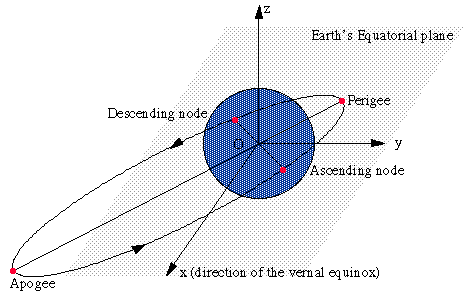 Kepler's Laws, complete with links to interactive
video animation of the laws!
Kepler's Laws, complete with links to interactive
video animation of the laws!In unit one we discussed space craft and planets moving in orbits and used the word trajectory a great deal. What we would like to do now is to examine what these orbits are and where they come from.
Johannes Kepler (1571 - 1630) developed the concepts associated with planetary motions, these concepts describe the positions and motions of objects in the solar system, what is remarkable is that he developed his laws based entirely on data collected by Tycho Brahe (1546 - 1601) who collected all his observations of the planets without the use of telescopes! Kepler showed that the orbits of the planets were indeed elliptical and not circular. Isaac Newton (1643 - 1727) explained why Kepler's laws worked in terms of the law of universal gravitation and also in terms of his laws of motion. For detailed discussions of these laws you may wish to visit some of the following links:
 Kepler's Laws, complete with links to interactive
video animation of the laws!
Kepler's Laws, complete with links to interactive
video animation of the laws!
 Newton's explanation for why objects travel in orbits.
Newton's explanation for why objects travel in orbits.
From Kepler's laws we get the following:
The planets revolve around the Sun in elliptical orbits with the Sun at one focus of the orbit.
This statement can be generalized to explain the motion of satellites about the Earth and indeed it can be generalized to explain the behavior of all the objects traveling in the solar system. This is quite clearly a simplification - there are a number of things this definition does not account for such as collisions etc. - but for our purposes it is adequate! In fact Kepler's law more accurately states that:
If two objects interact gravitationally, each will describe an orbit that is a conic section out of the common mass of the pair. If the objects are permanently associated, their orbits will be ellipses. If they are not permanently associated with each other, their orbits will be hyperbolas.
The latter part of this law explains that comets or similar objects have hyperbolic orbits and visit the sun only once.
For the purpose of our work in this lesson series we will assume that the objects we are dealing with all have elliptical orbits.
There are two definitions of ellipses both of which will prove useful in this lesson series they are given below:

An ellipse is a set of points in the plane such that the sum of the distance from two fixed points (called foci) remains constant.
Note the maximum diameter is called the major axis and the minimum diameter is called the minor axis, the intersection of the axes is often referred to as the center (c) of the ellipse

An ellipse is a set of points in the plane whose distance from a point F (the focus) is e (the eccentricity) times its distance from the line l (the directrix) where F is not on l.
While the ellipses defined above do indeed describe the shapes of the orbits of interest to us, these definitions are for ellipses in a plane. The solar system is clearly three dimensional rather than planar and so if we wish to describe orbits more fully we need to develop some further vocabulary and ultimately some further mathematical relationships.

To enable discussion about Earth centered orbits a coordinate system called the Earth-centered coordinate system has been developed. The center of the Earth is regarded as the origin, the x-y plane contains the equator and is called the Earth's equatorial plane, the positive x-axis points in the direction of the vernal equinox (the place where the Sun's orbit is in line with the equator as the Sun moves from the northern hemisphere to the southern hemisphere).
Some resulting vocabulary
Six orbital elements now completely determine the parameters of the orbit.
For a more detailed discussion of these parameters or Keplerian Orbital Elements click on the orbit button.
1) Make two constructions using GSP:
2) Using the two GSP sketches created in 1, vary the parameters and determine relationships between:
3) Write a short paragraph describing the influence of the eccentricity on the shape of the ellipse.
HINTS - by clicking on the movie buttons below you can watch a movie of the loci (constructed using GSP sketches) and the role of the parameters
 Go to unit
3,
Go to unit
3,  return to welcome
page.
return to welcome
page.